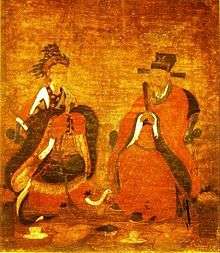Queen Noguk
| Queen Noguk | |
 | |
| Korean name | |
|---|---|
| Hangul | 노국대장공주 |
| Hanja | 魯國大長公主 |
| Revised Romanization | Noguk Daejang Gongju |
| McCune–Reischauer | Nokuk Taech'ang Kongch'u |
| Posthumous name | |
| Hangul | 인덕왕후 |
| Hanja | 仁德王后 |
| Revised Romanization | Indeok Wanghu |
| McCune–Reischauer | Intŏk Wanghu |
| Korean Personal Name | |
| Hangul | 왕가진 |
| Hanja | 王佳珍 |
| Revised Romanization | Wang Gajin |
| McCune–Reischauer | Wang Kajin |
Queen Noguk (?-1365), also known as Queen Indeok, was a Mongolian princess and later queen of Korea, who followed the Yuan Dynasty custom of marrying Goryeo princes into the family line. Her Mongolian name was Borjigin Budashiri (孛兒只斤 寶塔實里).
Wedding and death

She was the queen of the reformist monarch, King Gongmin. Although she was a Mongolian princess, Queen Noguk always supported Goryeo and her husband.
Despite the extremely close relationship between King Gongmin and her, they were childless. Queen Noguk became pregnant fifteen years after marriage, but died in 1365 from complications related to the childbirth.
After her death, King Gongmin became indifferent to politics and entrusted a great task to the Buddhist monk, Pyeonjo, who was executed in 1371. King Gongmin was killed in his sleep by Hong Ryun (홍륜), Choe Man-saeng (최만생), and others in 1374.
Genealogy
Ancestors
| Ancestors of Queen Noguk | ||||||||||||||||||||||||||||||||||||||||||||||||||||||||||||||||||||||||||||||||||||||||||||||||||||||||||||||||||||||||||||||||||||||||||||||||||||||||||||||||
|---|---|---|---|---|---|---|---|---|---|---|---|---|---|---|---|---|---|---|---|---|---|---|---|---|---|---|---|---|---|---|---|---|---|---|---|---|---|---|---|---|---|---|---|---|---|---|---|---|---|---|---|---|---|---|---|---|---|---|---|---|---|---|---|---|---|---|---|---|---|---|---|---|---|---|---|---|---|---|---|---|---|---|---|---|---|---|---|---|---|---|---|---|---|---|---|---|---|---|---|---|---|---|---|---|---|---|---|---|---|---|---|---|---|---|---|---|---|---|---|---|---|---|---|---|---|---|---|---|---|---|---|---|---|---|---|---|---|---|---|---|---|---|---|---|---|---|---|---|---|---|---|---|---|---|---|---|---|---|---|---|
| ||||||||||||||||||||||||||||||||||||||||||||||||||||||||||||||||||||||||||||||||||||||||||||||||||||||||||||||||||||||||||||||||||||||||||||||||||||||||||||||||
Legacy
Queen Noguk's memory lived on into the next dynasty, as according to the Annals of the Joseon Dynasty,.[1]
Queen Noguk was depicted by actresses Seo Ji-hye in the 2005 Korean MBC drama Shin Don, and Park Se-young in the 2012 Korean SBS drama Faith, as well as Bae Min-Hee in the 2012-2013 Korean SBS drama The Great Seer.
See also
References
- ↑ Entry dated 1497, during the 3rd year of Prince Yeonsan's rule